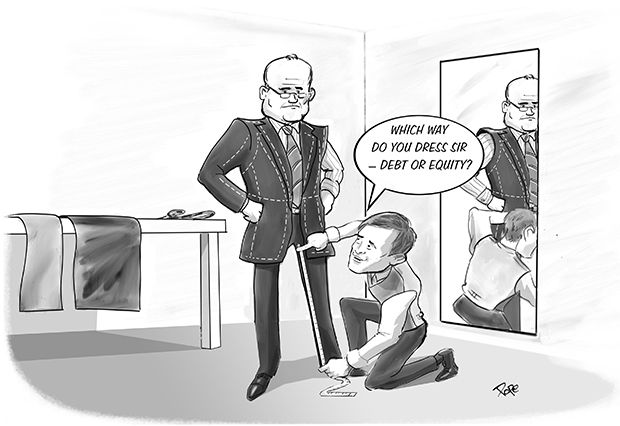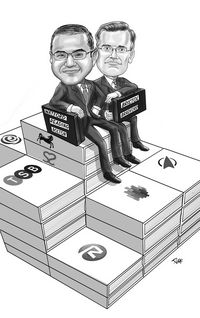Patchy issuance and the demand for diversification required banks to provide both variety and innovation this year. In matching its reputation for structuring with a sharply increased flow of deals, Societe Generale is IFR’s EMEA Structured Equity House of the Year.
Over most of the last decade, Societe Generale has been very much the “other” French bank when it came to the equity-linked markets: heavy on innovation but light on volume. SG did not feature in the top 10 of the EMEA equity-linked table for full-year 2013, its sixth absence in a decade.
Yet the bank has worked on far more IFR Award-winning structured equity deals than many of its larger rivals, picking up gongs for Amorim Energia in 2013, ArcelorMittal in 2009 and La Caixa/Criteria CaixaCorp in 2008.
“We’ve previously been accused of being just a French bank,” said Jose Antonio Gagliardi, head of equity syndicate at SG. “We had to ensure we no longer rely on the French issuer universe.”
Notwithstanding the traditional quiet of August and an October snuffed out by market weakness, SG was printing deals every month in 2014 through to September. Well into the second quarter, SG was one of only two banks to have completed more than a handful of trades – and it was the first to top US$1bn in league table credit.
Over the year, the bank completed the same number of deals in Germany and Spain as it did in its home market, as well as printing trades in Belgium, Italy and the Czech Republic. It diversified by sector and brought a healthy mix of debutants and repeat issuers. Its tally of 13 deals during the awards period – not including an unusual trade for unlisted Siclae – was bettered only by two other banks.
“Flow plus variety is what investors need,” said Bruno Magnouat, head of equity-linked origination. “As a bank we need to be in the flow, but we also want to add value throughout.”
Those remarks refer to one of the defining themes of the CB universe in 2014: the zero coupon. Over the awards period, SG was on five of the 10 zero deals, including the upsized €500m 2019 CB for German healthcare group Fresenius that was priced through 0.10%–0.90% guidance in March.
Also pricing with a 0% yield was the €470.2m exchangeable by Czech electricity supplier CEZ into Hungarian oil and gas group MOL, providing rare CEE paper. With CEZ committing to sell its 7.3% stake underlying the bonds, but MOL having first right of refusal on any sale, the bonds cannot be converted for three years of the 3.5-year tenor. The option to settle in cash provided the client with extra flexibility.
Value was also represented by SG’s knack for structuring around complex situations and client requirements.
Innovation included helping Telefonica monetise a stake in Telecom Italia that it did not yet possess. The €750m 2017 mandatory exchangeables used a 14.8% stake held indirectly in a vehicle being unwound due to competition concerns.
Enough outright demand was captured for an accompanying delta placing to be cut to €276m, from €575m originally, with further flexibility provided by the option to settle in cash if Telefonica has not yet received the shares.
100% debt
But SG’s unique flair for the product was best shown in deals that revealed the bespoke nature of structured equity. In March, Fresenius issued €500m of convertible bonds while purchasing call options from Credit Suisse with a strike price equal to the CB conversion price to remove dilution entirely.
SG was a joint bookrunner with UniCredit, compared to Credit Suisse’s sole global co-ordinator, but it was the only one of the three to be employed when subsidiary Fresenius Medical Care tried something similar in September. This time SG was provider of the matching call options.
Corporates learned to their cost the risk of packaging derivatives with convertibles when Lehman Brothers collapsed and their calls disappeared with it. In the case of FMC’s €400m CB, the issuer is fully protected. If SG were to go bust, then rather than FMC losing its hedge, it is bondholders that would notice the change; they would become creditors of the French bank for anything owed above nominal value.
100% equity
Addressing very different needs, SG also brought to market Europe’s first-ever 100% equity credit CB under IFRS accounting rules for French engineering consultancy Assystem. That trumped earlier efforts from more seasoned issuers ArcelorMittal and Volkswagen, which used mandatory structures to boost equity content above 80%.
The ODIRNANE structure comprised a perpetual bond issue convertible for the first seven years that can then be called or become straight debt with a step-up to six-month Euribor plus 800bp. Dilution was minimised through the use of net-share settlement.
“We wanted to fund our growth, to strengthen our equity base, to limit coupons – and at the same time to minimise dilution. Not an easy equation,” said Gilbert Vidal, Assystem’s CFO.
“Bringing together its expertise in hybrid convertible bonds and equity-linked instruments, Societe Generale was deeply involved by Assystem for a highly innovative convertible hybrid bond instrument ‘ODIRNANE’ which both addressed our needs and maximised investor interest.”
To see the digital version of the IFR Review of the Year, please click here.
To purchase printed copies or a PDF of this report, please email gloria.balbastro@thomsonreuters.com.







